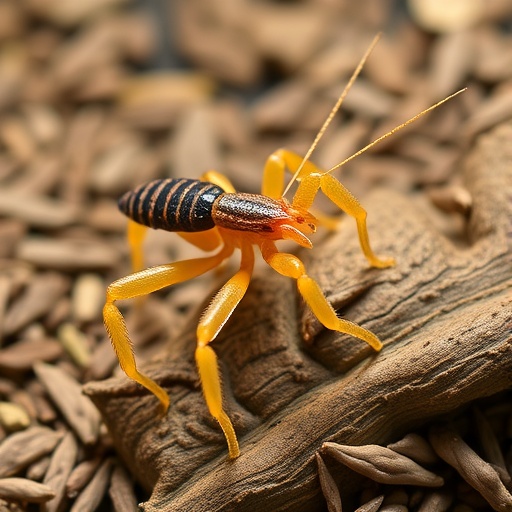In an intriguing development within the realm of entomology, recent research has unveiled a new species of a genus known as Huiyingosmylus. This investigation, spearheaded by Liu, Ren, and Wang, establishes this discovery within the backdrop of the Middle Jurassic period in China. The research not only identifies this new species but also highlights a strikingly abnormal foreleg morphology that diverges significantly from established norms within the family Saucrosmylidae. Such morphological variations carry significant implications for understanding evolutionary adaptations and ecological niches occupied by these ancient insects.
The genus Huiyingosmylus, initially described in 2013, has now given rise to a new species that reflects the complexity and diversity of Neuroptera, commonly known as lacewings. Lacewings are distinct not only for their striking green hue and delicate wing structure but also for their pivotal role in various ecosystems as predators of pest insects. The identification of the new species adds another layer of complexity to an already fascinating group, harnessing a wealth of information about early insect life during a dynamic period in Earth’s history.
Among the most striking features of the new species is its foreleg morphology. The forelegs of this newly identified Huiyingosmylus exhibit forms that deviate from the conventional morphology observed in both modern and fossil relatives. This peculiar foreleg structure may suggest specialized behaviors or ecological adaptive strategies that were essential for survival during the Jurassic. Other insects in the Saucrosmylidae family typically exhibit forelegs adapted for capturing prey, so these structural differences raise questions about the predatory and survival strategies employed by this species.
The research team conducted a thorough analysis of the fossil specimens, employing cutting-edge imaging techniques to clarify the morphological characteristics. The compressive fossilization process typical of the Middle Jurassic era offered unique preservation, enabling researchers to discern even the minutest details that distinguish this new species from its counterparts. Through this meticulous examination, they were able to construct a more comprehensive phylogenetic tree that situates Huiyingosmylus within the broader context of evolutionary history among Neuroptera.
Furthermore, the implications of these findings extend beyond mere identification. Understanding the morphology of ancient insects provides crucial insights into ecological interactions and environmental conditions prevalent during the Jurassic period. It paints a picture of an ecosystem that supported varied life forms, revealing how the predecessors of today’s insects evolved under specific ecological pressures. The evolution of such features as foreleg morphology varied significantly, depending on the ecological role each species played within its environment.
This discovery not only enriches our understanding of the evolution of Neuroptera but often has broader implications for the study of insect diversity and evolutionary biology. Morphological anomalies, such as the ones observed in Huiyingosmylus, can serve as indicators of environmental shifts or specific adaptations to ecological challenges faced by these organisms. The insights gathered from studying such extremes can illuminate the resilience and adaptability of life in ancient ecosystems.
Excitingly, this newfound knowledge can enhance ongoing discourse regarding insect evolutionary paths. The findings challenge scientists to rethink previously held beliefs about the limits of morphological variation and the capabilities of species to adapt or develop new functions over vast timescales. As the scientific community processes and interprets these findings, it fuels a growing discourse on the evolutionary trajectories of insect lineages.
In summary, the identification of this new species of Huiyingosmylus not only provides a deeper understanding of its distinct morphological characteristics but also poses an array of questions regarding the adaptability of ancient insects and their ecological interactions. As researchers look to the past, there are countless lessons to be learned about resilience, adaptation, and the evolutionary paths that have led to the rich biodiversity we observe today.
Through this study, Liu, Ren, and Wang illuminate a lesser-known corner of the Jurassic epoch, offering a glimpse into a world that has long been buried in time. Their findings underscore the importance of paleontological research in piecing together the intricate history of life on Earth. With each new discovery, the complex narrative of evolution continues to expand, painting a richer tableau of the past and igniting curiosity about the future of biodiversity.
The findings, soon to be published in the journal Sci Nat, will undoubtedly stimulate further research into the Saucrosmylidae family and inspire a renewed interest in the evolutionary biology of insects. As the scientific community seeks to decipher the intricate puzzle of life’s history, every new species illustrates the magnificence of evolution, adapting and thriving amidst environmental challenges that have since shaped the living world.
As the community eagerly awaits the full publication of these findings, the implications of the research resonate, highlighting the critical role of paleontological studies in understanding the past and informing the future of ecological research. The rich tapestry of life, as woven through time, presents endless horizons for exploration, urging researchers to delve deeper into the evolutionary legacies left behind by creatures like Huiyingosmylus.
By unearthing such groundbreaking discoveries, scientists continue to challenge and expand the frontiers of knowledge, fostering a sense of wonder about the natural world that has existed for eons before humans inhabited the planet. The tale of Huiyingosmylus serves as a powerful reminder of life’s relentless pursuit of adaptation and the ongoing mysteries of our planet’s past.
Subject of Research: The discovery of a new species of Huiyingosmylus with abnormal foreleg morphology from the Middle Jurassic of China.
Article Title: A new species of Huiyingosmylus Liu et al., 2013 reveals an abnormal foreleg morphology from the Middle Jurassic of China (Neuroptera, Saucrosmylidae).
Article References:
Liu, XT., Ren, D. & Wang, YJ. A new species of Huiyingosmylus Liu et al., 2013 reveals an abnormal foreleg morphology from the Middle Jurassic of China (Neuroptera, Saucrosmylidae).
Sci Nat 112, 91 (2025). https://doi.org/10.1007/s00114-025-02045-4
Image Credits: AI Generated
DOI: 10.1007/s00114-025-02045-4
Keywords: Neuroptera, Saucrosmylidae, Huiyingosmylus, Middle Jurassic, insect evolution, paleontology.




